History : Historic Milestones
Talgo Series 1 (1942)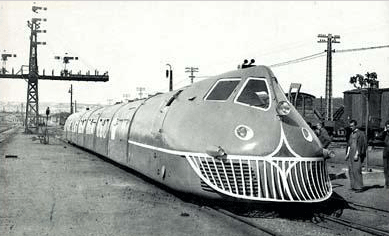
October 1942
Talgo I tests begin between Madrid and Guadalajara Speeds of 115 km/h are reached.
October 1944
Talgo I reaches 135 km/h on the descent at La Cañada, on the Madrid-Ávila line.
1950
Three Talgo II locomotives and 32 railcars arrive in Spain, built at American Car Foundry (A.C.F.), in the United States,under technical management by Spanish engineers.
March 1950
The Head of State officially inaugurates the Talgo II on a Madrid-Valladolid route.
March 1950
A Talgo II train breaks the speed record in Portugal on the Lisbon-Porto line.
Talgo Series 2 (1950)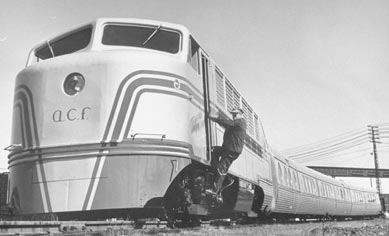
July 1950
The Talgo IIs commence commercial service on Madrid-Hendaya line with four trains a week at a maximum speed of 120 km/h.
August 1964
Talgo III trains with 2000 T Locomotives start their service on the Madrid-Barcelona route.
June 1966
The first run in Spain at 200 km/h. is performed by a Talgo III trainset with a 2000 T locomotive during tests between Seville and Los Rosales.
July 1968
The Head of State travels on board Talgo III, which performs its inaugural journey on the direct Madrid – Burgos line.
November 1968
The first official train journey between Madrid and Paris without passengers changing at the border performed by a Talgo III RD trainset pulled by a KM 3001 locomotive, Virgen de Lourdes, which arrives in Paris after crossing the border at Hendaya.
Talgo Series 3 (1964)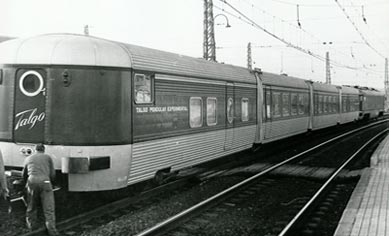
June 1969
The first Talgo International enters into commercial service, equipped with variable gauge axles and name the Catalonian Talgo. It covers the Barcelona-Geneva service as part of the European Express Train Club (EET).
January 1972
After 21 years, the Talgo II is withdrawn from service. Palencia-Madrid was the last route covered.
May 1972
New speed record for a diesel powered train: a Talgo III train with pneumatic suspension, pulled by a Renfe 3005 T locomotive, Virgen de la Bien Aparecida, reaches 222 km/h. on the Madrid-Barcelona line between the stations of Azuqueca and Meco, in Guadalajara.
May 1974
The first Talgo sleeping car, the Barcelona Talgo, covers the Barcelona-Paris route.
July 1980
The first commercial service using the Talgo Natural Tilting trains. Madrid-Zaragoza is the route served by the initial trainset.
July 1986
Increased maximum commercial speed on main Spanish network. Talgo III and Talgo Tilting trains begin running in Spain at 160 km/h.
April 1987
Luxury Class Talgo Sleeping Cars enter service on Madrid-Barcelona route.
Talgo RD (1968)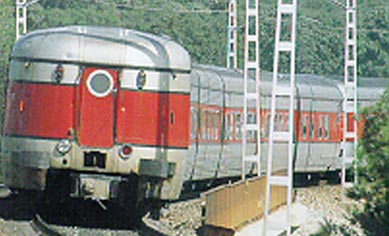
May 1987
The Talgo International trains are integrated into the “Eurocity” network.
1988
Talgo Trains test run in the Northwest Corridor
December 1990
A group of Talgo Tilting coaches reach the speed of 500 km/h., on the test-bench in Munich, beating the speed record reached on the Bench.
June 1992
The German company Deutsche Bahn (DB) signs the contract ordering 112 coaches for their Train+Hotel project.
March 1993
Talgo grants Sumitomo Metals Industries, Ltd. (Japan), license to apply the variable gauge axles or RD system to bogies made by the important Japanese company.
April 1994
Talgo Rail Inc. is awarded a contract brought for tender by the Washington State Department of Transport (WSDOT-USA) to perform commercial services between Seattle (Washington) and Portland (Oregon). This Talgo becomes the first European train with a regular commercial service in the United States.
Talgo Series 4 (1980)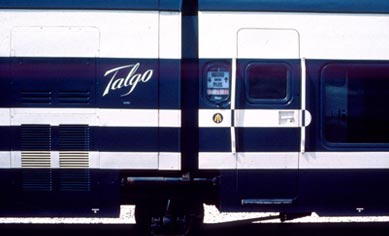
May 1994
Four Talgo trainsets begin nighttime service between Berlin-Munich and Berlin-Bonn. Talgo Deutschland GmbH activities begin, a company handling the maintenance of the Deutsche Bahn Talgo trains, with headquarters in Berlin.
High Speed tests with a High Speed prototype Talgo 350 trainset on the Madrid-Seville line between the towns of Mora and Urda in the province of Toledo. A speed of 303 km/h is reached, the maximum allowed by the locomotive.
October 1994
Showcase runs of Talgo tilting rolling stock for railway authorities and technical experts in the States of Oregon, California, Missouri, Ohio, Pennsylvania, Massachusetts, Connecticut and Maine.
Renewal of the contract signed with WSDOT for the lease of the TP 200 trainset to continue regular passenger services in the "Pacific Northwest Corridor".
November 1994
The Talgo 350, a High Speed prototype train, reaches 360 km/h, the maximum speed allowed by the catenary installed on the Göttingen - Hanover line (Germany).
April 1995
Seattle (Washington-U.S.A.)- Vancouver (British Columbia, Canada) passenger service resumes with a daily service of two Talgo 200 tilting trains.
July 1995
Talgo obtains the AENOR ISO 9001 Quality Certificate for manufacturing of and after sales service for trains, as well as for the design and manufacturing of maintenance equipment for workshops.
Deutsche Bahn (DB) in Germany orders 38 coaches from Patentes Talgo S.A. for the Munich-Hamburg nighttime service.
February 1996
A Talgo 200 train and a special open car, equipped with variable gauge Talgo axles are tested on Russian Federation lines.
July 1996
Washington State Department of Transport orders two Talgo 200 trains and at the same time, Amtrak also orders another train.
April 1998
Collaboration agreement signed with Adtranz for the design and manufacturing of Talgo High Speed locomotives (350 km/h) and traction equipment for Talgo BT traction units.
A contract is signed for Sporting Sponsorship of a Class 49 regatta crew.
October 1998
Presentation of a new generation of Talgo XXI Tilting trains, with traction units at the head and rear. This presentation takes place at the 150th Spanish Railway Anniversary commemorative Fair, held at Barcelona’s “Estacion de Francia” and attended by HM King Juan Carlos I of Spain.
Talgo 21 (1998)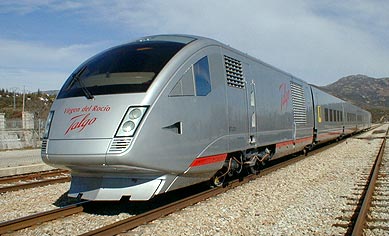
November 1998
At the railway facilities in Pueblo (Colorado USA) testing is concluded, with highly satisfactory results on the “Talgo Tilting 200” trainset acquired by the Washington State Department of Transport.
Commercial passenger service commences with four TP 200 trainsets acquired by Amtrak and by WSDOT for the – Vancouver (BC, Canada) and Seattle (WA)-Eugene (OR) corridor.
December 1998
RENFE contracts the supply of 159 new 7th generation Talgo Tilting coaches which will be able to form full variable gauge trains with the Talgo BT traction units.
Talgo and ADtranz sign a technical collaboration contract for the designing and manufacturing of self-propelled Talgo Tilting trains, with electrical traction and variable gauge axles.
1999
Talgo, Inc. signs a 20-year contract with Amtrak and WSDOT for the maintenance of the Amtrak Cascades trainsets.
January 1999
Tests begin on RENFE tracks of the first Talgo XXI train.
Talgo BT (1998)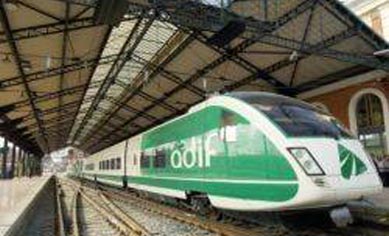
February 1999
Presentation to the press of the new self-propelled Talgo XXI train, with a trip from Madrid Chamartin to Guadalajara.
The “Talgo 49 class” sailing team classifies in the eighth position in the World Championship regattas held in Melbourne (Australia), achieving Spain’s participation in the Sidney 2000 Olympic Games.
March 1999
The last 15 Talgo Tilting 200 coaches remaining in the United States, used in the trainsets leased to Washington State (USA) over the past few years disembark at the port of Santander.
May 1999
Talgo Purchases the railway division of the Finnish company, Rautaruuki, engaged in the design and manufacturing of double-deck coaches for 200 km/h and specially designed freight wagons.
June 1999
First Talgo Technological Innovation Prize awarded, endowed with 4 million pesetas. The Talgo Group expands with the incorporation of the Finnish company, Talgo Transtech Oy, manufacturer of double-deck high speed coaches, special freight wagons and railway rolling stock in general.
Talgo Series 7 (1999)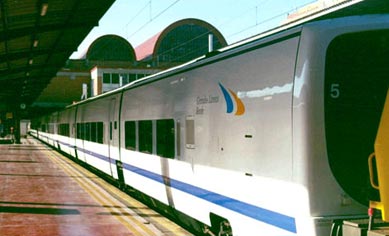
July 1999
Incorporation of variable gauge motor bogie to the Talgo BT traction unit on the new Talgo XXI. Test runs begin of the Talgo XXI on Spanish gauge track and UIC gauge, automatically changing the distance between the wheels on the RENFE variable gauge installation at the "Puerta de Atocha" station in Madrid.
October 1999
The ISO 9001 is obtained for the design and manufacturing of railway vehicles.
January 2000
Manufacturing of the second diesel BT traction head at the Aravaca Works (Madrid) is completed. It has a variable gauge bogie and is named “Virgen de los Reyes”.
Dynamic tests on Spanish gauge track of a complete Talgo XXI train set, composed of two Talgo BT diesel power heads, six 7th generation passenger coaches and a 7th generation cafeteria car begin.
The sailing team “Talgo 49er”, composed of Santiago López Vázquez and Javier de la Plaza, are selected to represent Spain at the Sydney 2000 Olympics.
Talgo 350 (2000)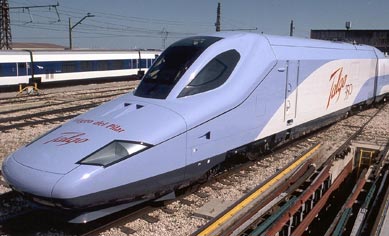
February 2000
Talgo XXI tests on two tracks with different gauges, automatically changing the distance between the wheels at the variable fixed installation at RENFE’s “Puerta de Atocha” station.
Talgo is awarded the 1998 Export Prize given by the Chamber of Industry and Commerce of Madrid.
March 2000
Talgo acquires the American company "Transportation and Transit Associates LLC" (TTA LLC), established in New York state and specialized in the construction and repair of passenger coaches.
At the Vilanova and la Geltrú Railway Museum, Talgo ceremoniously gives 4 coaches belonging to the old Talgo II series to the Museum. Amongst these 4 coaches there is an end-saloon coach. These coaches, together with the locomotive from the same series named “Virgen de Begoña” already on display at the museum, will complete a small train set of this famous train.
The Talgo sailing team, 49 Class, becomes World Champion in the World Championships held in Mexico.
April 2000
On a return trip from Madrid to Puente Genil (Jaen) the Self-propelled Variable Gauge Version of the Talgo XXI Diesel Engine Unit is presented to the Press. The trip is covered in a record time running on the Madrid-Seville high speed standard gauge line to Cordoba and continuing on conventional Spanish gauge track from Cordoba to Puente Genil. The gauge changing operation from standard gauge to Spanish gauge is performed at the gauge changing installation without stopping the train in a relatively fast process virtually unnoticeable to the passengers.
Talgo 250 (2007)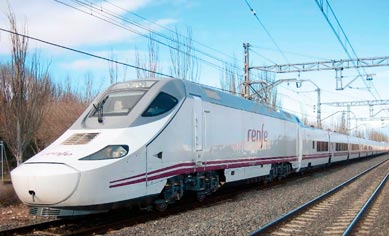
May 2000
Talgo is awarded the Prince Philippe Award for Business Excellence in the Competitive Company and Internationalization sections. The Prizes, given by His Royal Highness, Prince Philippe, are received by the Chairman of the company at an event held in the new Ministry of Science and Technology.
The new high speed train Talgo 350 is presented to the Press at the Talgo maintenance workshop in Las Matas (Madrid).
Test runs of a Talgo Tilting train are performed along various routes of the Croatian network. For the first time since the Balkans War, the same train set covers the Ploce-Mostar-Zagreb line, running through the Bosnian territories.
June 2000
Test runs of a Talgo Tilting train set are performed on the routes in the Republic of Kazakhstan.
The subsidiary North American company Talgo LRC, LLC, based in Livingston (Montana), specialized in the construction, repair and lease of locomotives, is established.
July 2000
At an event held at the Higher Council of Scientific Research, under the presidency of the Minister of Science and Technology, Her Excellency Mrs. Ana Birulés, the “First Talgo Prize for Technological Innovation” is given by the qualified jury to the study titled “Automatic measuring system of the wear and tear of catenary”, presented by Mr. Salvador Garcia Molina, Mr. José Luis Aparicio and Mr. Pedro Manuel Martinez. At the same event, the second edition of the Talgo Award is announced.
August 2000
The new 7th series generation of Talgo Tilting trains starts commercial service on the Madrid-Barcelona line.
September 2000
The Talgo sailing team, class 49, formed by Santiago Lopez Vazquez (captain) and Javier de la Plaza (forward), trained by Alejandro Abascal (Gold medal at the Moscow Olympics), finish in 4th place, with Olympic Diploma, at the Sydney Olympics 2000 (Australia). A penalty at the start of the tenth regatta means they lose the chance of a medal. With this classification, the Talgo team becomes the leader of the world ranking in this category.
In consortium with the company ADtranz, a bid for the supplying of high speed trains Talgo 350 is presented to RENFE.
December 2000
The first Talgo 350 train set runs at a speed of 340 km/h on the Spanish Madrid-Seville High Speed line.
January 2001
Talgo participates in the 2001 EURORAIL fair held in Madrid.
February 2001
RENFE signs a contract for the supplying of 3 new Talgo Tilting coach trains sets of the 7th Series.
March 2001
The Talgo 350 train breaks the speed record on the Spanish network by running at a speed of 359 km/h on the Madrid-Seville line.
The Talgo-Bombardier consortium is awarded the supply of 16 Talgo 350 trains by RENFE to perform the fastest commercial services on the new Madrid-Barcelona line. Talgo participates in SIFER 2001 in Paris.
April 2001
The Talgo Aravaca workshops (Madrid) are closed due to town planning requirements after more than 50 years of use as a maintenance base for the Talgo II and Talgo III trains, and for the 352, 353 and 354 locomotives, belonging to RENFE.
May 2001
The 2nd Talgo Award for Technological Innovation was given to the study titled “Formal Representation of the Management System for Railway Traffic – ERTMS – as a Tool for Safety Studies”, presented by a team of 10 people headed by Professor Antonio Hernando Grande, Material Magnetism Professor from the Complutense University of Madrid and Manager of the Applied Magnetism Institute. Doctor Jaime Tamarít Rodriguez took part in this study in an advisory capacity.
June 2001
Mr. Lucas Mª de Oriol López-Montenegro becomes the Chairman of Talgo, replacing Mr. Jose Luis de Oriol e Ibarra, who was appointed as Honorary Chairman of the Company.
May 2002
After more than 38 years of service, the lasts series “Talgo 2000” type 160 B locomotive is taken out of service by RENFE on the 20th of May. It is the “Virgen de Gracia”, 352 009-5 that covers its last journey hauling a Talgo III Hendaya-Madrid Talgo III train set.
The readers of the magazine "La Actualidad Económica" and the daily newspaper "Expansión", award Talgo the prize for the “Company with the Greatest Exporting Commitment”, in a recognition to the intense dedication in expanding its commercial activities on the international markets.
On the 29th of May, the test runs of the high speed prototype train Talgo 350 begin on the new Madrid-Barcelona line, starting out from the Montagut station (Lerida).
June 2002
The Official College of Industrial Engineers of Madrid give Talgo the “Honorary Mention to the Most Innovative Company” of the year.
July 2002
ON the 10th of July a Talgo XXI train, belonging to GIF (Administrator of railway Infrastructure) breaks the “WORLD SPEED RECORD” with diesel traction by running at a speed of 256 km/h on the Olmedo-Medina test track, also belonging to GIF.
On the 17th of July, the Minister of Science and Technology, Mr. José Piqué give the 3rd Talgo Prize for Technological Innovation to the study titled “Continuous Monitoring of Wheel Eccentricity”, presented by Mr. Alberto Ibañez Rodriguez, leading a group of 16 researchers and technicians. The prize awarding takes place at the Higher Council of Scientific Research in Madrid.
October 2002
A Talgo 350 prototype breaks the speed record on the Spanish network by running at a speed of 362 km/h on the new Madrid-Barcelona line.
October 2002 EURAILSPEED 2002 Congress takes place in Madrid, specializing in High Speed Railways. At this event, Talgo presents a natural size scale model of the future Talgo 350 AVE (S-102) of which RENFE has 16 units ordered for the new Madrid – Barcelona line.
The sailing team of the Talgo 49 class, wins the Spanish Championship in its category.
December 2002
Mr. Carlos Palacio Oriol becomes the Chairman of Talgo, replacing Mr. Lucas Mª de Oriol López-Montenegro.
2003
The Washington Department of Transportation (WSDOT) buys fifth Talgo trainset.
June 2003
In Madrid, the Minister of Science and Technology, Josep Piqué i Camps chaired the awards of the 4th Talgo Award for Technological Innovation granted by Patentes Talgo, S.A.
The winning project, “Innovative materials for Noise and Vibration Reducing Applications”, with a cash prize of thirty thousand euros, was drafted by Cristina Ventayol, under the management of Salvador Borrós and Nuria Agulló, all of them from the Laboratory of Material Sciences, from the Molecular Engineering Group of the Chemical Institute of Sariá, dependent on the Pompeu Fabra University.
July 2003
Two loco-hauled trainsets with sleeping cars are delivered to the Kazakh Railway Administration, “Temir Zholy•, which will provide nighttime services between the old capital city, Almaty and the new capital of Astana.
September 2003
Fulfilling the deadline fixed in the Acquisition contract, the AVE Business Unit of Renfe received the first Talgo 350 train in its AVE version (Renfe’s S-102). This unit will start off the certification tests for this type of train.
The “5th Talgo Award for Technological Innovation• is announced with 30,000 Euros in prize money.
October 2003
Renfe awards the Talgo-Bombardier consortium the supplying of 44 electric traction heads with variable gauge Talgo RD system.
November 2003
Talgo signs with Renfe a 14 year contract for the complete maintenance of the all the fleet of loco-hauled passenger coaches.
The Rivabellosa Factory obtains the environmental management system certificate ISO 14001
December 2003
The second Talgo 350 AVE (Renfe’s S-102) is delivered to Renfe.
February 2004
At a ceremony hosted in Barcelona, Her Highness Princess Cristina delivers the 2003 National Design Prize to the Chairman of Talgo.
March 2004
Renfe awards Talgo with the supplying of 10 hotel trains and 26 InterCity trains to the Talgo-Bombardier consortium, with two electric traction heads and with variable gauge Talgo RD system.
Renfe awards the Talgo-Bombardier consortium with the supplying of 30 Talgo 350 trains in Renfe’s S-102 version.
April 2004
The overhaul of 18 Talgo Tilting, VI Series trainsets including 9 coaches is completed.
June 2004
On a test run during the certification tests for Renfe’s new S102 trains, on the night between the 25th and the 26th of June, a Talgo 350 trainset (AVE S-102) reaches the speed of 365 km/h, obtaining a new high speed record with electric traction in Spain.
January 2005
The prize award of the 5th Talgo Award for Technological Innovation, with a cash prize of 30,000 euros is given to the industrial engineer, industrial engineer doctor and professor for Railways from the Higher Technical School of Industrial Engineers of Bilbao, Ernesto García Vadillo and his team for their work on the prediction and elimination of the track wave wear and for the reduction of vibrations and lower and medium frequency sound emissions.
February 2005
Renfe inaugurates the High Speed Line for Madrid-Lerida with the new Talgo 350 trains (AVE S-102). These trains will start service at an average speed of 200 km/h with a later speed increase to 250 km/h in the summer, once the signalling is switched from the Asfa to the ERTMS system, which will allow higher speeds. At a later stage, the speed will be increased to 280 km/h and finally in the future reaching speeds of 300 kilometres per hour.
Renfe starts the commercial service of the Talgo 350 (AVE S-102) train on the Madrid-Zaragoza-Huesca line, replacing the Talgo-Altaria, with a journey time of 2 hours and 40 minutes at an average speed of 200 kilometres per hour.
Talgo signs a 5 year complete maintenance contract with the Kazakh Railway Administration (Temir Zholy) for a period from January 2005 to December 2009 for the Talgo rolling stock currently in commercial service.
June 2005
Talgo and ADIF sign an agreement for the use of the Olmedo and medina del Campo (Valladolid) track with the aim of carrying out dynamic tests with the L-9202 locomotive (TRAV-CA project). By virtue of this agreement with a validity period of 5 months, ADIF will allow the temporary use of this infrastructure, mainly used for the tests on new generation rolling stock.
In the first tests, the correct functioning of all the systems of the locomotive were verified in order to carry out dynamic tests later. Various runs at a speed of 100 km/h in push and pull modes were successfully achieved. In future tests, dynamic tests at different speeds will be performed until the speed of 200 km/h is gradually reached.
Renfe’s Board of Directors approves an investment of 144.68 million Euros to purchase 10 Talgo Train-Hotel of 20 coaches each. They will cover distances of more than 1,000 kms, on the lines that join Barcelona to the Cantabrian coast and Andalusia. On the 23rd of June Talgo Oy (Finland) presents at Pasila Vanhat Veturitallit (the old locomotive depot) in Helsinki its new Double-Decker TALGO 22 designed for commuter traffic.
It is the first time that the Talgo 22 prototype is presented to the Press and the general public. The manufacturing of the prototype and test program performed assures that the technical characteristics and design for the comfort of the passengers will meet the highest standards in railway traffic.
September 2005
Talgo sells it subsidiary company TTA, LLC with offices in Hornell and Kanona (USA), belonging to the Talgo America group of companies.
October 2005
The Talgo-Bombardier consortium signs a contract with RENFE for the supplying of 18 High Speed Talgo 250 trains, 10 power heads for High Speed, designed for speeds of 250 km/h and with last generation equipment in a “push-pull” configuration, four safety systems and variable gauge system. The delivery period will be between December 2007 and August 2009.
The additional 10 power heads will be used to form 5 trainsets with Talgo coaches, already in use by Renfe and which will be modified for this “push-pull” configuration with power heads.
November 2005
The Board of Directors of Renfe approved the closing of the awarding of the contract made by the company in February and March 2004, corresponding to 30 high speed trains from the Talgo-Bombardier consortium to adapt the purchases, the delivery plans and the putting into service of the trains according to that set forth in the Strategic Plan for Infrastructures and Transport (PEIT) of the Ministry of Public Works. The material will not be delivered until 2009 and 2010.
December 2005
Talgo, Inc.(USA) obtains the ISO 9001 Quality Certificate for the maintenance and repair of railroad equipment.
January 2006
The presentation of the book on the History of Talgo “Talgo 1942-2005. From a dream to High Speed” written by Mr. Miguel Cano López-Luzzatti and Mr. Manuel Galán Eruste and printed by Revistas Profesionales S.L. was held at the Foundation of Spanish Railways, Fernán Núñez Palace. This event was chaired by Mr. Carlos de Palacio Oriol with the assistance of large number of top representatives within the railway, the diplomatic and the business worlds.
The EOI Business School awarded Talgo extraordinarily a prize for being one of the companies that have contributed most to transforming the Spanish economy over the past 50 years within the categories of Innovation and Technology, Sustainability and Entrepreneurship.
Talgo Oy supplies 20 double-deck night trains to the Finnish railway operator VR. These cars are constructed from aluminium, and travel at up to 160 km/h. It is important to emphasizse their excellent interior design. In the future these vehicles will operate on the nighttime services between Helsinki and Rovaniemi in Northern Finland. The first four cars will start their service at the beginning of February.
May 2006
Talgo will supply new last generation tilting trains to the Bosnia and Herzegovina railways using an ADF credit (Aid for Development Fund). The project covers the design, manufacturing and supplying of 9 trains including 9 coaches for each train and diverse maintenance equipment. Five of the nine trains will be fitted with seats for daytime services and room for 237 passengers per train. The remaining four trains will provide nighttime services and will have room for 186 passengers. These trains will cover international routes to Zagreb (Croatia), Lubian (Slovenia) and Belgrade (Serbia and Montenegro) from Sarajevo.
Talgo OY is awarded the supplying of 20 double-deck passenger coaches for the railway company VR Limited Talgo, to be delivered between Autumn 2007 and Spring 2008.
September 2006
During the last days of September, at the Talgo factory in Las Matas, the first Talgo 250 train from the 130 Series is assembled. It is made up of two driving heads and 11 intermediate series Talgo coaches. Static tests and electrical checks will be carried out for around two months, after which it will move out onto the track to start off the homologation trials.
Start of the overhaul and improvement program on Talgo trains running in Amtrak Cascades service. This overhaul includes mechanical inspections and replacement of parts and components scheduled as part the comprehensive Talgo preventive maintenance program. Additionally some of the improvements include trainset repainting, new leather seats, interior side panels, vestibule repainting and upgrade. Restrooms will be repainted and have new floors installed. The Bistro and Dining cars will have the interior décor updated.
For more information refer to http://www.wsdot.wa.gov/Projects/Rail/CascadesTrainsets/
November 2007
The first train AVE S-130 (Talgo 250) enters into commercial service on the Madrid-Gijon line, travelling at 200 km per hour on the conventional tracks and 250 km/h on the international ones.
March 2008
Participation at the 6th International High Speed Congress “UIC HIGHSPEED” held in Amsterdam from the 17th to the 19th of March.
Participation in the 3rd Job and Professional Training Fair (3FPO), held for the third consecutive year at the IFEMA Fair Center on March 26th-27th.
TALGO receives the "Agustín Plana" award by unanimous decision of the General Assembly of Engineers of the Metallurgical Research Center (CENIM), the highest award bestowed as an acknowledgment regarding the merits of people, companies and institutes engaged in the high-tech research, which have contributed to the industrial development of our country. The award was handed out at the Assembly Hall of the Spanish National Research Council (CSIC), chaired by its president Carlos Martinez.
The business magazine Actualidad Económica, on the occasion of its 50th anniversary, honored the 50 most influential personalities of the Spanish business and financial sectors that have invested in innovation and new technologies, being TALGO one of the awarded companies. The event that took place on May 12th was chaired by Their Royal Highnesses the Prince and Princess of Asturias.
Visit of Their Royal Highnesses the Prince and Princess of Asturias to Talgo's plant in Las Matas II (Madrid).
July 2009
21st July 2009: sale of two trainsets new Series 8 to the State of Wisconsin, for $47,5 million dollars.
Talgo receives the “AWARD FOR AN INNOVATIVE CAREER” bestowed by El Mundo newspaper.
The Catalán Talgo train (Talgo III RD) performed its last trip after 41 years of service.
Commissioning of the line Madrid - Valencia with Talgo 350 trains belonging to Renfe, and with the designation of high-speed train AVE Series 112.
May 2011
INTERNATIONAL RAIL FORUM 2011 - Talgo took part in the VIII International Rail Forum that was held in Ifema (Madrid) on May 10th, 11th and 12th.
TALGO participates in the II edition of the International Congress on Railway Technology (Rail Spain), which was held on June 14th, 15th and 16th.
18th June 2011 - Talgo signs a contract with the Russian railways, RZD for the supply of 7 passenger trains consisting of 140 carriages.
On October 24th TALGO was awarded with the “European Citizen” Prize in the category of European Trajectories.
On October 26th the Spanish Consortium, led by Talgo, Renfe, Adif and OHL was awarded the High-Speed Mecca-Medina mega-contract in Saudi Arabia, the most important railway project to date.
On January 25th the framework agreement between the renowned and recognized Russian railway institute VNIIZht and TALGO is signed in order to develop a TALGO train with Spanish technology and adapted to the Russian climate needs and track gauge.
VISIT TO SPAIN OF THE SAUDI MINISTER OF TRANSPORT - His Excellency Dr. Mr. Jubarah bin Eid Al-Suraiseri, the Saudi Arabian Minister of Transport, has visited Spain with a delegation headed by the President of Talgo, Mr. Carlos Palacio Oriol, the President of RENFE, Mr. Julio Gómez Pomar, and the President of Ineco, Mr. Pablo Vázquez.
The high-speed Dual Train, Talgo 250 Dual, that connects Madrid and Galicia, was presented to the media on June 9th and it entered into commercial service on June 17th, contributing to reduce the distance between both cities.
TALGO ACCOMPANIES THE KING OF SPAIN IN HIS TRIP TO MOSCOW - for many years, Talgo and the Russian Railways have maintained a close relationship with evident results: Talgo trains have been tested in Russia in 2009-2010, performing variable gauge and braking tests, high-speed test at 200 km / h and Talgo trains' response test in the route Moscow- Brest.
Talgo rejects a contract with the Argentine company "Emepa" to maintain the Talgo IV trains in this country.
Talgo receives the GOLDEN STATUTORY MASTER PRICE.
TALGO SIGNS A NEW CONTRACT IN KAZAKHSTAN. Talgo shall supply to the public operator of Kazakhstan, PP (Passazhirskie Perevozki), subsidiary company of the railway administration KTZ, 603 passenger cars (21 trains) for long distance services in the whole territory of the Republic of Kazakhstan.
TALGO ANNOUNCES THE UPCOMING OPENING OF A NEW PLANT IN ANKARA. The company “Patentes TALGO” has a high interest in cooperating with the railway expansion, both in the High-Speed field and other commuter, regional and long distance traffic segments, planned by the Turkish government.
Talgo announces its intention to float on the Stock Exchange through an IPO addressed to the international institutions.

 Talgo Inc. US Corporate Office
Talgo Inc. US Corporate Office